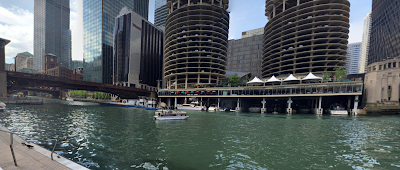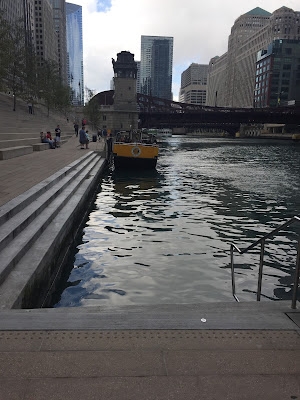Swimming the Distance: How Do We Get from Here to There?
Last summer, 11 intrepid individuals jumped into the Cal-Sag Channel as part of the Cal-Sag Plunge. This monumental occasion signified that the more than 100-year history of the river as a sewage canal is over and recreation in, on, and along the water is here to stay.
But is the river really safe enough for swimming? Who says so? And how do they know?
Please join Friends of the Chicago River, along with other water quality experts, policy advocates, and urban swimming champions as we explore these questions and discuss how to make swimming in the Chicago River system a reality.
Speakers include David Barra, New York Open Water; Jessica Dexter, Environmental Law & Policy Center; Willie Levenson, Human Access Project; and David St, Pierre, Metropolitan Water Reclamation District of Greater Chicago. A panel discussion will follow.
Click here for the summit agenda.
Chicago River Marathon SwimRenewal
of a Chicago Athletic Tradition
The
Chicago River is a vibrant and dynamic venue combining a working river, world
class architecture, recreation and city landscapes pulsing through the heart of
Chicago like an artery of greek god, Poseidon, Olympian, God of the Oceans, and king of the sea gods.
This venue creates the opportunity for the city to return to its world class athletics involving swimming that was exceeding popular in the early 1900's. The bridges and shoreline create a natural viewing area for hundreds of thousands of visitors, tourists along the shores like a “stadium” built for economic and corporate business interests.
So we will see if the vision can become a reality.
History
Begun
in 1908, the Chicago River Swim capitalized on the bustling downtown and
athletic events of the day. These swims took place during what is considered by many to be the most polluted periods of the river, before it was turned to the Mississippi and still discharging into Lake Michigan. Yet today even Lake Michigan has water quality challenges that everyone swims in without thinking twice. Yet the river suffers from the mystique of un-educated fear and factual reporting of being much cleaner according to many.
Today, building on our community’s history, strong work
ethic, and as national transportation hub for commerce, organizations have come
together to expand an already successful regional swim series by
adding a series of swims to the Chicagoland area to reinvigorate a century old river marathon
swim tradition.
The river swim rain-child is the idea of recognized open water swimmers Doug McConnell and Don Macdonald. With each having a swimming pedigree spanning the English Channel, Tampa Bay, Boston Harbor, around Manhattan Island, Kawa'i channel, and National Masters Championships they are more than qualified experts in a sports growing so fast it has recently been added to the Olympic stage.
Capitalizing
on recent successes in water quality, community environmental awareness and
economic development forged by other partners, Doug and Don saw the opportunity
to focus on the Chicago River as a sporting venue.
We
believe Chicago will once again be the epicenter of urban aquatic athletics
(i.e., swimming, kayaking, canoeing, etc.) offering River and lake swims
similar to events hosted around Manhattan Island 29 miles, New York; Amsterdam’s
canal swims 1-5 miles; or Boston’s Light House swim conducted for over 100
years 8 miles among others.
River Athletics
Anecdotes
tell us Chicago has hosted many famous Olympians such as Johnny Weissmuller,
Buster Crabbe and that venerable sports club like the Illinois & Chicago
Athletic Club hosted events as early as 1908.
Chicago's first great swimmer, H. Jamison Handy,
won a bronze medal in the breaststroke as a member of Central YMCA Olympic
squad in 1904. Handy improved the crawl with an underwater exhaling technique
that brought him record-setting national championships between 1906 and 1909.
During the 1960s, Hinsdale Central dominated state pool competitions producing
Olympian and world record holder open water champion John Kinsella also an
English Channel swimmer that later attended Indiana University swimming for
James ‘Doc’ Councilman with Mark Spitz and Gary Hall Sr.

CHICAGO MARATHON SWIM News Clip
Silver Loving Cup Has Been Presented by W. H. Thompson of
Illinois A. C.
News Reprint. CHICAGO, Aug. 9, 1910 — One of the richest prizes
ever offered for an event of Its kind is the $1000 silver loving cup that has
been donated by William Hale Thompson, the first president of the Illinois
Athletic club of Chicago, as a perpetual trophy to be competed for by swimmers
in the annual Chicago river marathon, which will take place on August 13. Rules
for, the race are made, especially stringent this year, a rigid examination by
physicians being mandatory before swimmers will be allowed at the starting
point. Contestants failing to pass the examination will be barred, and those
showing signs of any weakness whatever during any part of the race will be
compelled to retire from the competition at once. The marathon is to be held
under the auspices of the Amateur Athletic union and Is open to all registered
athletes. The course, decided upon officially at a meeting of the Illinois
Athletic club athletic committee, will be from the Chicago life savings station
to Jackson boulevard on the river.
River Marathon Swim – Concept
The event is in the earliest of planning stages, with many questions to be answered and approvals sought but the possible athletic and economic outcome is without question a potential milestone to the arteries that have been for 100 years diseased with pollution, congestion, and mis-use as a sewer that is until recently.
We
envision a nominal 5k (2.4 mile) swim commencing in the south branch at Ping
Tom Park located in the south loop, China Town area at the new river kayak,
canoe and recreation basin launch. Proceeding North approximately 1.5 miles
along the right hand side of the channel turning into the main stem branch heading
East toward Michigan Avenue. The planned exit will be in the Riverwalk area
where accessibility has been built into the river bank.
Future
alternative distance swim events are being planned from 1 mile to 10 miles for
different qualified levels of swimmers from triathlon to open water racers from
entry points such as East Bank Club, Goose Island, or River City.
Each
potential future event has its own conduct requirements, safety and planning
needs to be well vetted with all stakeholders. Combining swim events with other athletic
events such as canoe and sculling races, traditionally held in the river offers
other benefits to organizers.
Entry from Ping Tom Park, South Loop/Chinatown
with participant access from nearby Redline trains and public support
facilities makes this entry point ideal to support the gathering and start of
such future events.
The view looking north to Willis Tower, offers
swimmers a straight line course to warm-up and prepare for the busier and more
confined walled channel.
View north from water level. You can see
concrete embankments, both sides that are not to be approached.
Bridges proceeding north in financial district begin
potential public viewing but also have pilings to be avoided slightly outside
of embankment areas.
In this stretch facing north companies have
water taxi service docks for commuters
View just before the intersection of south,
north branches and main channel (wolf point) where course turns right (east) toward
Lake Michigan. This entire stretch has low to water river walk
for access/egress. Boats can pull up and dock here for bars so be aware of
private small water craft.
The Riverwalk steps are the planned exit point.















